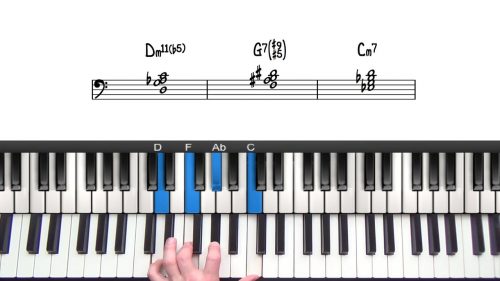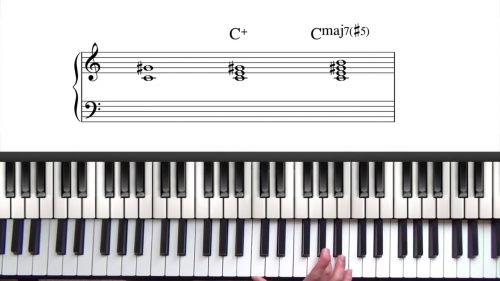Half Whole Diminished Scale Tutorial
The half-whole diminished scale is an 8 note symmetrical scale. The scale alternates half and whole steps until the scale starts again. This is why we refer to it as a symmetrical scale, because the repeating interval pattern takes you back to the note that you started on.
Due to the repeating interval pattern of half and whole steps, there are only 3 different half-whole diminished scales to learn for all 12 keys. The following 3 groups share the same half-whole diminished scale:
Group 1 : C, Eb, Gb,A
Group 2 : C#, E, G, Bb
Group 3 : D, F, Ab, B
If you look closely you will see that the notes in each group make up 4 different diminished chords. Diminished chords also have a symmetrical interval structure so Cdim7, Ebdim7, Gbdim7 and Adim7 all contain the same notes but are simply different inversions.
In the context of the half-whole diminished scale, you only need to learn one scale for each of these 3 groups (each scale starts on a different note but contains the exact same notes and intervals).
Lesson Downloads
-
Half Whole Diminished Scale Groups File Type: pdf
Practice Tips
-
Firstly try to memorise the 3 groups of diminished scales.
-
Practice playing up and down the scale tones sequentially.
-
Next try to create patterns using different combinations of intervals.
- Remember that the half whole diminished scale is suited to play over altered dominant chords, and can also be used over the II-7b5 chord in a minor 251.








Hi Hayden. On the last ii-v-i progression you played the half whole diminished scale of the ii chord over the entire progression and not just over ii chord. Can you explain the theory behind that? Thanks.
Hi Josh,
A useful relationship to understand is that when playing over minor 251s, you can use the HW dim scale built from the 5 chord and play that over both the 2 and 5 chords.
The line you are referring to, I transcribed that line from a Kenny Barron recording.
I can’t think of a simple theoretical relationship as to why the notes of E HW Dim work over A7.
But… if you analyse the scale degree of the notes played over A7, we have the 11, 5, b13, b7, root, 5, 11 & #9 (in relation to A7). 3 of the primary chord tones are present (root, 5th and b7) which gives it a strong harmonic foundation. The alterations b13, #9 are also present to add colour.
Another thing that sprung to mind when I transcribed the line was that over A7, he is simply playing the notes of D Dorian, which anticipates the resolution to D-.
However, the biggest ‘takeaway’ I took from transcribing the line, was how he resolves into the 1 Chord… the double grace note into the 9th of D-7 which sounds beautiful.
This is then something that I could apply to any 251.
Another important point which may help you out here…
Dominant chords are transitional chords, they are tense and dissonant sounding and so you will find that you have a lot of freedom in terms of the notes you choose to play. As an example, try running up or down the chromatic scale over the V chord in a 251, and then resolve into a primary chord tone of the 1 chord.
The key is to always have a point of resolution in mind.
Hope this makes sense… have a play around with the things mentioned above and let me know how you get on :-)
Cheers,
Hayden
thanks!
In this lesson on the whole half scale you played this scale over the minor flat 5 chords rather than the Locrian one or two. Do you feel that this is preferable or just an option? Is there a lesson in detail on the Locrian. If you use the Locrian, which one do you favor? Thanks, Ed
Hi, Hayden. Sometimes I feel confuse about II V I concept. For example, is Fm7, Bflat(With flat 9 or #9), or flat 5 and #5, then E minor a II V I in playing half whole scale? Any other situation is on the face likes II V I but not II V I so that half whole scale cannot be used?
How can I judge which part of a score can use half whole scale? I am now studying to play Emily as posted but don’t know how to do.
Hello Hayden a couple of things I noticed, on the 1st half whole diminished lick, the left hand voicing for the 1st and 2nd chords are notated as Fb rather than Gb. I’m not trying to appear picky, I know typos happen however for a new student like myself it makes me wonder about other possible mistakes especially with diminished scales for instance as I might not know how they are supposed to sound and end up practicing them wrong. I realize I can watch you play the chord on the keyboard but I am learning to read music as well and often go by the written sheets for practice. Also in the previous lesson on diminished chords, the second group begins with Db but in this lesson that group begins as C#. I know they are enharmonic, but is there any significance to your choice of name.
Hi Bill,
Firstly my apologies for the Fb / Gb typo… little typos have crept into some of the lessons and I will fix this one. If there is ever a discrepancy, go with what is being played on the keyboard and not what is showed in the notation.
For diminished scales I find it easier to visualise the scales on the piano rather than memorising the notation. Here are some key things to remember with diminished scales that I find very useful:
– For any dominant chord, we can find the half-whole diminished scale by alternating half / whole steps starting on the root. Or alternatively, alternating whole / half steps starting on the b9.
– I find that by memorising this construction pattern, it removes our reliance on the notation completely, as we can see the scale shape on the keyword. This is the end goal so the quicker we can visualise this on the piano, the better.
For memorising the groups:
– Take any dominant chord, for example C7, and then move that chord up in minor 3rd intervals to get C7 / Eb7 / Gb7 / A7 – and then if we go up a minor 3rd again we are back at C7. This would be the first group.
– All four chords in the group use the exact same notes for the half whole diminished scale.
– For C7, starting at the root, we would have: root / b9 / #9 / 3 / #11 / 5 / 13 / b7
– Those exact same notes create the exact same scale degrees when we play them over Eb7, Gb7, and A7.
– It’s important to be able to see this so take a shell voicing for each of the 4 dominant chords in your left hand, and play the scale in your right hand whilst analysing the scale degrees in relation to the underlying chord.
– When we create patterns using the scale, these patterns also work over all four chords. Often the patterns are created by moving things around in minor 3rd intervals. For example, in your right hand, play the notes in an arpeggio like manner : C, Db, Gb, then move that pattern up a minor 3rd to play Eb, E, A, then up a minor 3rd again to play Gb, G, C, and then finally A, Bb, Eb, and then we are back to the beginning. We could also look at this as playing the root, b9, and #11 of each of the dominant chords in the group.
– The key is the resolution to ‘break out’ of the diminished scale. Try resolving into a chord tone such as the 3rd of the 1 Chord and you can practice this over all 4 dominant chords in the group.
Here are some other lessons on diminished scales that you might find useful:
pianogroove.com/jazz-piano-lessons/diminished-patterns-licks-improvisation/
pianogroove.com/bossa-nova-lessons/useful-diminished-trick-for-any-251/
One thing that is worth highlighting with Jovino’s lesson (the second lesson referenced above) is that he is applying the diminished scale over Cdim7, in which case we start with a whole step, then half, then whole etc… When we are applying the diminished scale over an altered dominant chord, we start with a half step, then whole etc…
Finally, no there is no significance to having Db in the first lesson, and C# in this lesson. Apologies for the unnecessary confusion here.
I hope that helps Bill.
I created this tutorial many years ago and since then we have greatly improved the lesson layout, notation, and also I want to refresh this course on diminished material with some new theory lessons which is on my to-do list.
Let me know if I can be of further assistance here.
Cheers,
Hayden
Hi Hayden,
So you implied in the application section that you can use this scale over chords which have unaltered 13 as long as you don’t “sit” on it.
I usually use the altered scale for that but it is nice to know I can use both.
Thanks.